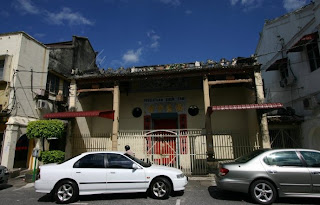The Shun Tak Association in Taiping is one of the many Chinese associations in town. The more well-known ones are the Kwantung Association, Hokkien Association and Foo Chow Association. These are large associations with large membership. The Shun Tak Association is one of the smaller associations with a present membership of around 60 only. This inevitably means that the association do not have much fund. The association is an active one and has numerous activities throughout the year for its members but the main problem lies with the maintenance of its heritage building. To renovate the building back into good condition needs more than a million ringgit. That is an amount that the association do not have. So, instead of leaving the building to rot, the association has let it out to a banner printing company to get some income to do repairs and maintenance. It is a pity, because the beauty of the building is totally "lost" under the cover of banners and advertisements. It must be mentioned that this is the only Shun Tak Association in the whole country with such a beautiful building. All the other Shun Tak Associations - in Ipoh, KL and even Penang - are housed in modern shop lots. Because of its small membership, the heritage building is simply too big to handle, so at present, the Taiping association too has moved into another of its property in a modern shop house.
This is what the Shun Tak Association building in Taiping looked like a few decades ago. It housed the association and its main income at that time was from rental of tables for mahjong players.
This is what it looks like today. The sign board is still there but the mural above it has faded.
Today, the entrance is no longer visible and it is being covered with the name of the advertising company that rents the place.
Cracks start to appear all over its wall and a lot of money is needed, if a renovation program is to be undertaken.
In the meanwhile, with the heritage building being rented out, the association is now housed on the first floor of this shophouse building.
The ground floor is rented out to a law firm and the top floor is also rented out to a resident. It is hoped that the old heritage building will catch the attention of the authority or organisations which has interest in renovating it to its original glory and make it into a tourist attraction. The Shun Tak Association Taiping committee is looking forward to lease it out to someone who has this in mind. With proper planning and care, I am sure this is a good investment for anyone with the money to spare. Examples of how heritage buildings are turned into successful tourist attractions can be found in Penang and Malacca. So, why not in Taiping too?































